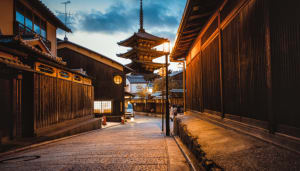
Dream Trip to Japan: Exploring the World’s Most Visited Destination
For years now, Japan has worn the crown as one of the most coveted travel destinations in the world. From glossy magazine covers to trending hashtags, the Land of the Rising Sun consistently tops global “Best Places to Visit” lists. And the numbers back it up: in 2024, Japan welcomed a record-breaking 36.9 million international visitors, shattering its previous high set before the pandemic. Visitor spending topped 8.1 trillion yen (about $51 billion USD), cementing Japan’s reputation not only as a cultural powerhouse but also as one of the world’s great travel economies.
But statistics only tell part of the story. What makes Japan so magnetic isn’t just the scale of its visitor numbers — it’s the kaleidoscope of experiences that await every kind of traveler. Samurai history and cutting-edge tech sit side by side. Michelin-starred restaurants exist a few steps away from street food carts sizzling late into the night. Ancient temples overlook neon-soaked districts where anime fantasies spill into real life. Japan is a place where tradition and futurism collide beautifully, and travelers return again and again because no single visit is ever enough.
If you’re planning your very first trip, or maybe returning to see what you missed last time, we’re here to guide you through Japan’s essential stops, seasonal secrets, and hidden highlights. Our journey will take us through Osaka, Kyoto, and Tokyo — the golden trio for first-timers — while also exploring when to go, who’s traveling, and why this island nation has become the world’s ultimate travel dream.
Why Japan Keeps Winning “Best Place to Travel”
It’s no accident that Japan has ranked at the top of global travel awards year after year. According to the Japan National Tourism Organization (JNTO), the top reasons international visitors give for coming are:
Food and drink: From sushi to ramen, Japan is a culinary capital of the world. Tokyo alone boasts more Michelin-starred restaurants than Paris and New York combined.
Culture and history: Samurai castles, Shinto shrines, and centuries-old tea ceremonies draw millions who want to step back in time.
Pop culture and entertainment: Anime, manga, J-pop, and gaming attract younger travelers in droves. In fact, surveys show that more than 40% of first-time visitors under 30 say pop culture was their main inspiration for visiting.
Nature and seasons: Japan is unique in that each season feels like an entirely new country. Cherry blossoms in spring, fireworks and festivals in summer, fiery maple leaves in autumn, and snowy hot spring retreats in winter all lure travelers year-round.
Safety and convenience: Japan consistently ranks among the safest countries in the world, with one of the most efficient transport networks ever built.
With this combination, it’s easy to see why people of all ages — from backpackers to retirees — make the journey. But the “where” matters too, and most first-timers start with three unforgettable cities.
Osaka: Japan’s Kitchen and Playground
If Japan were a three-course meal, Osaka would be the appetizer — bold, flavorful, and just the right amount of chaotic. Known as “Japan’s Kitchen,” Osaka is where food is an experience, not just a meal. Locals proudly use the word kuidaore, which translates to “eat until you drop,” and the city lives up to that motto.
Walking through Dotonbori, the city’s entertainment hub, you’re immediately enveloped in neon lights, giant mechanical signs (think: a 30-foot crab moving its claws), and the sizzling aromas of street food stalls. This is where you’ll find takoyaki (grilled octopus balls), okonomiyaki (savory pancakes layered with meat and cabbage), and skewers of kushikatsu fried to golden perfection. Unlike Tokyo, where dining can feel formal, Osaka encourages spontaneity — you wander, you snack, you wander some more.
But food is only part of the fun. Osaka has a reputation as Japan’s most easygoing, party-loving city. Its nightlife pulses with energy, from themed bars to world-class clubs. If you love clubbing, karaoke, or simply bar-hopping in neighborhoods like Namba and Shinsaibashi, Osaka delivers. Families flock to Universal Studios Japan, home to Super Nintendo World, while history lovers head to Osaka Castle, a reconstruction of the 16th-century fortress once ruled by legendary samurai Toyotomi Hideyoshi.
For many travelers, Osaka is the perfect first stop because it’s approachable, less overwhelming than Tokyo, and endlessly entertaining. Whether you spend two days or five, the city sets the tone for an unforgettable trip.
Kyoto: A Step Back in Time
A short train ride from Osaka transports you to another world entirely. Kyoto, the former imperial capital of Japan, feels like stepping into a living museum. With its preserved wooden townhouses, cobblestone streets, and geisha sightings in the historic district of Gion, Kyoto captures the soul of old Japan.
The city is home to over 1,600 Buddhist temples and 400 Shinto shrines, including the famous golden pavilion Kinkaku-ji and the vermillion gates of Fushimi Inari Taisha that wind endlessly into the forest. For those fascinated by samurai history, Kyoto offers glimpses into the traditions that shaped Japan’s warrior culture. Tea ceremonies, kimono rentals, and even sword-fighting lessons allow visitors to connect with that heritage in immersive ways.
But Kyoto isn’t just a relic — it’s a living, breathing city. Its culinary scene rivals Osaka’s but leans toward refinement: multi-course kaiseki dinners, matcha sweets, and cozy ramen shops tucked into alleyways. Evenings here are slower, quieter, and more intimate, offering travelers a peaceful contrast to Osaka’s sensory overload.
For couples, Kyoto is especially romantic in spring when cherry blossoms frame the Philosopher’s Path, or in autumn when fiery red maples surround temples like Tofuku-ji. For families and older travelers, the pace of Kyoto allows for easy exploration without the constant rush.
Tokyo: The Electric Heart of Japan
Then comes Tokyo — a city so vast and vibrant it feels like its own universe. Home to nearly 14 million residents (and over 37 million in the greater metro area), Tokyo is where Japan’s futuristic image truly comes alive.
Here, skyscrapers light up districts like Shinjuku and Shibuya, where the world’s busiest pedestrian crossing sees more than 3,000 people move through every green light cycle. In Akihabara, anime and gaming culture dominate, with multi-story arcades, maid cafés, and shops selling every collectible imaginable. In contrast, neighborhoods like Asakusa preserve tradition with markets leading up to the grand Senso-ji Temple.
Tokyo is also a city of experiences. You can watch a sumo tournament at Ryogoku Kokugikan, attend a car meet where tuned machines echo the underground drift culture, or dress up as Mario and Luigi to go kart through the streets (yes, really). Sports enthusiasts can play soccer on rooftop fields with skyscraper views, while fans of Japanese pop culture flock to real-life Pokémon Centers and Naruto-themed attractions.
The food scene is unmatched: Tokyo holds over 200 Michelin-starred restaurants, but you can just as easily savor a $3 bowl of steaming ramen at a 24-hour shop. Accommodations range from capsule hotels costing under $30 a night to five-star penthouses overlooking Tokyo Bay. Whatever your budget, Tokyo delivers.
For many travelers, Tokyo is the crescendo of their Japanese journey — the place where every dream, from food to fashion to fantasy, comes to life.
When to Visit: Seasons of Japan
One of the secrets to Japan’s repeat success as a travel destination is its seasonality. Unlike destinations that peak in summer only, Japan offers four distinct experiences:
Spring (March–April): The iconic cherry blossom season. Parks and riverbanks turn pink, and hanami (flower-viewing picnics) attract locals and tourists alike. This is the most popular time to visit, particularly for couples and first-time travelers. In 2024, nearly 40% of international arrivals in spring were motivated by sakura season.
Summer (June–August): Festivals (matsuri) fill the streets with parades, lanterns, and fireworks. Families travel during school breaks, while younger travelers head to Hokkaido to escape the heat. Music lovers flock to Fuji Rock Festival.
Autumn (October–November): The fall foliage (koyo) rivals cherry blossoms for beauty. Photographers and nature enthusiasts come to capture temple gardens framed in fiery reds and golds. Older travelers often prefer this season for its cooler weather and fewer crowds.
Winter (December–February): Japan’s ski resorts in Hokkaido and Nagano attract skiers from Australia, Europe, and the U.S. Snowy landscapes pair perfectly with onsen (hot springs). Illuminations light up city streets, creating a festive atmosphere for families and couples.
Who’s Traveling to Japan?
Japan’s appeal spans generations, but travel trends show some interesting patterns:
Young travelers (18–30): Often motivated by anime, gaming, nightlife, and budget travel options like hostels and capsule hotels. Many come during summer or gap years, sometimes through working holiday programs.
Families: Drawn by theme parks (Tokyo Disneyland, Universal Studios Japan), child-friendly attractions, and seasonal events like fireworks festivals. Most visit during summer breaks.
Couples: Romantic getaways in Kyoto, hot spring towns, and cherry blossom season. Honeymoons in Japan are increasingly popular.
Older travelers (50+): Guided cultural tours are common, focusing on temples, gardens, and traditional crafts. Autumn is especially favored for comfortable weather.
Travel Programs and Experiences
Japan is famously easy to navigate on your own, thanks to its world-renowned train system, but travel programs can add convenience and depth. Popular options include:
Japan Rail Pass: Unlimited train travel on JR lines, ideal for covering Osaka, Kyoto, and Tokyo in one trip. Regional passes also exist for Hokkaido, Kansai, and beyond.
Small group tours: Food tours in Osaka, anime tours in Tokyo, and heritage tours in Kyoto. Perfect for travelers who want insider guidance.
Study abroad and cultural exchange: Thousands of students come each year to study Japanese language or participate in cultural immersion.
Working holiday programs: Available for travelers aged 18–30 from select countries, allowing extended stays.
Luxury curated travel: Private ryokan stays, geisha dinners, and behind-the-scenes temple access cater to high-end travelers.
Themed attractions: From samurai sword lessons to the Naruto theme park, there’s a program for every niche interest.
The Dream Itinerary: 10 Days in Japan
For first-timers, a 10-day itinerary offers a taste of everything:
Days 1–3: Osaka. Explore Dotonbori, Osaka Castle, Universal Studios Japan, and street food adventures.
Days 4–6: Kyoto. Visit Kiyomizu-dera, Fushimi Inari, Arashiyama bamboo grove, and enjoy tea ceremonies.
Days 7–10: Tokyo. Dive into Shibuya and Shinjuku, experience Akihabara, visit the Pokémon Center, catch a sumo match, and take a day trip to Mt. Fuji or Nikko.
Budget travelers can make this work for under $100 a day, while luxury travelers can easily spend several thousand. The beauty of Japan is that it accommodates both ends of the spectrum.
Final Tips Before You Go
Book early for cherry blossom and autumn seasons — flights and hotels sell out 6–12 months in advance.
Consider the JR Pass if traveling between multiple cities; otherwise, regional passes or pay-as-you-go can be more cost-effective.
Download translation and map apps, and consider renting pocket Wi-Fi for seamless navigation.
Respect local etiquette: remove shoes indoors, avoid loud phone calls on trains, and follow onsen rules.
Support local communities by visiting lesser-known towns like Kanazawa or Takayama, especially as Kyoto battles overtourism.
Your Dream Trip Awaits
Japan is not just another destination — it’s a journey into another world, one that surprises you at every turn and lingers in your memory long after you return home. Whether you’re tasting street food in Osaka, walking through Kyoto’s temple gardens, or gazing up at Tokyo’s neon skyline, Japan promises experiences that feel larger than life yet deeply personal.
And the best part? You don’t have to plan it alone. Reach out to us, and we’ll help you book and plan your dream trip to Japan — from flights and accommodations to tours and hidden gems you won’t find in the guidebooks. Let us handle the details so you can focus on the adventure of a lifetime.
